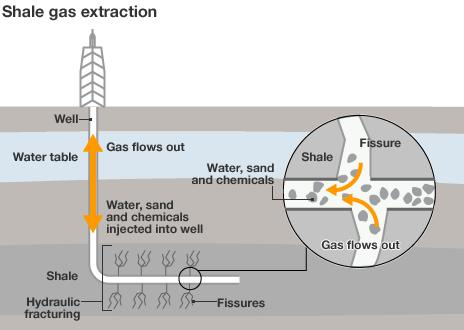Indian Economy
Tight/Shale Oil
- 19 Nov 2021
- 4 min read
Why in News
Cairn India will partner US-based Halliburton to start shale exploration in the Lower Barmer Hill formation, Western Rajasthan.
Key Points
- Shale Oil and Gas:
- Tight Oil: The key difference between shale oil and conventional crude is that the former, also called ‘tight oil’, is found in smaller batches, and deeper than conventional crude deposits.
- Shale Gas: Unlike conventional hydrocarbons that can be extracted from the permeable rocks easily, shale gas is trapped under low permeable rocks.
- Extraction Process: Extraction requires creation of fractures in oil and gas rich shale to release hydrocarbons through a process called hydraulic fracking/fracturing.
- It requires a mixture of ‘pressurised water, chemicals, and sand’ (shale fluid) to break low permeable rocks and have access to the shale gas reserves.
- Top Producers: Russia and the US are among the largest shale oil producers in the world, with a surge in shale oil production in the US having played a key role in turning the country from an importer of crude to a net exporter in 2019.
- Associated Concerns: Shale oil and gas exploration faces several challenges other than environmental concerns around massive water requirements for fracking and potential for groundwater contamination.
- Shale rocks are usually found adjacent to rocks containing usable/ drinking water known as ‘aquifers’.
- While fracking, the shale fluid could possibly penetrate aquifers leading to methane poisoning of groundwater used for drinking and irrigation purposes.
Conventional and Unconventional Resources
- Conventional oil or gas comes from formations that are straightforward to extract product from.
- Extracting fossil fuels from these geological formations can be done with standard methods that can be used to economically remove the fuel from the deposit.
- Conventional resources tend to be easier and less expensive to produce simply because they require no specialized technologies and can utilize common methods.
- Unconventional oil or gas resources are much more difficult to extract.
- Some of these resources are trapped in reservoirs with poor permeability and porosity, meaning that it is extremely difficult or impossible for oil or natural gas to flow through the pores and into a standard well.
- To be able to produce from these difficult reservoirs, specialized techniques and tools are used.
- Prospects of Shale Oil Exploration in India:
- Currently, there is no large-scale commercial production of shale oil and gas in India.
- State-owned ONGC had, in 2013, found prospects of shale oil at the Cambay basin in Gujarat and the Krishna Godavari basin in Andhra Pradesh.
- However, it concluded that the quantity of oil flow observed in these basins did not indicate “commerciality” and that the general characteristics of Indian shales are quite different from North American ones.





